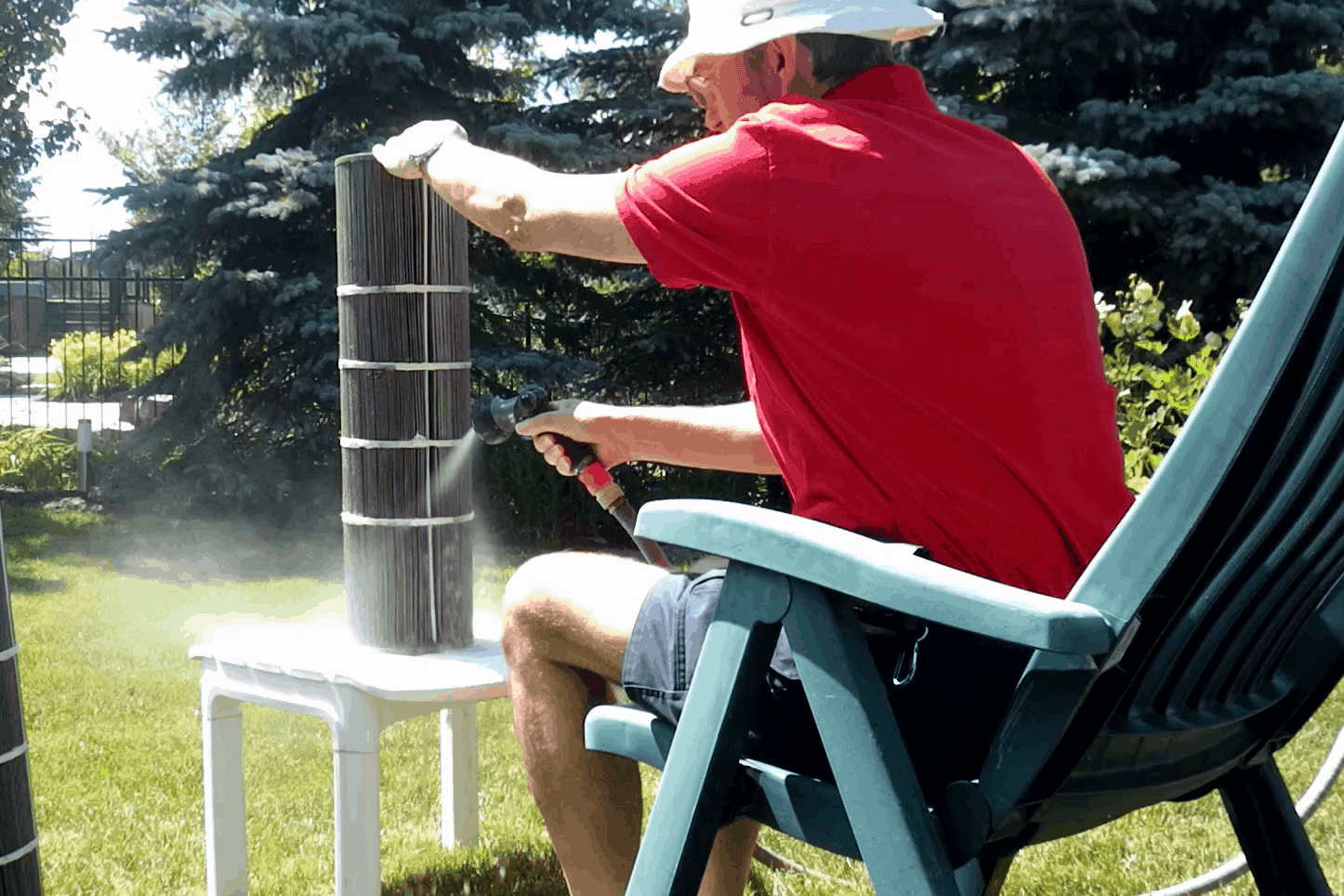Removing the filter
I’m not going to dwell on this too much, because every filter system is different. The general steps are to turn off the pump, release the pressure, release the strap that holds the top to the bottom, remove the top and get the cartridges out. Refer to your manual! The one tip I will share is that if you have a brass nut that tightens the clamp, be careful with it. It is much softer than the steel bolt, and the threads will wear down, or get cross-threaded. You can only fix it with a tap and die set so many times before there isn’t enough metal left!
Washing the filter

The instructions that came with my filter suggested washing it with a hose with no nozzle. The local pool store apparently uses a pressure washer which wears away and breaks the straps that hold the pleats in place. My compromise is to use a hose nozzle that directs the water stream down at an angle. I set the cartridge on a stool and I sit on a chair. I then hold the cartridge upright with one hand and direct the stream of water from top to bottom, cleaning a 1″-2″ stripe down the cartridge.

Then I turn the cartridge to present a new dirty stripe and repeat until I get back to where I started. How do I know if it’s clean? I watch the water running out of the cartridge at the bottom. Because I use a white stool, I can see dirty water and bits of debris coming out as the water flows on the white surface. When it looks like clear water, I stop. My own experience is that going around the cartridge twice is sufficient.
This method avoids crouching over the cartridge; the angled nozzle means my grip on the hose gun isn’t awkward, and the lawn gets watered and even some nutrients. The white surface gives some reassurance that the filter is pretty clean. The downside is that my legs get pretty wet, but I imagine hosing the things down, crouched over at at the end of a driveway, doesn’t exactly leave you bone dry either.
Chemical soak
Especially with older filters, hosing the filters down doesn’t always do it. You may experience the pressure in the filter tank rising to “clean-me” pressures in unreasonably short times after a wash, or possibly your chlorine generator begins to complain about low flow. That’s the time for a chemical soak or new filters.

Using a dolly to make the weight manageable
The problem with doing a soak is two-fold: finding a suitable container, and managing the weight of the container once it’s full of liquid. My pool filter has four cartridges, and they don’t fit inside a garbage can. I have a larger bin, but it’s not very high. Also, when you put four cylinders together, there’s a lot of empty space between them, so you need a lot of liquid. I’ve devised containers with flexible sides that conform to the cylinders (in my mind) but the problems of supporting everything and containing the liquid (safely!) in a structure that one can store between soaks are more than I care to deal with. One solution is to take them to be cleaned by to a pool company, which involves two trips and some expense.
My solution is to soak the bottoms of all four, and then flip them and soak the tops. So it takes 24 hours for the entire soak. I start early so I can flip them before bedtime, and replace them the next morning. I put the bin on a four-wheel dolly, so I can move it easily.
I find that I have to add a small amount of water (more than the standard dilution) to ensure the solution level is above the centre line of the cartridges, so the entire surface gets processed. Alternately, I suppose I could add a brick or something to raise the solution level.
Avoiding a chemical soak for as long as possible
What the chemicals (essentially sodium hydroxide!) do is dissolve the oils that collect from suntan lotion and so on. I suppose you could try to restrict that… you could also stop people swimming, but that may not go down well. In the last few years I have come to suspect that the commercial product that I have added to the pool water to slow evaporation and thus heat loss hasn’t helped, and I have stopped using that. Another product to remove phosphorous actually explains that it forms a coating on the filter which has to be removed later; so I don’t use that either. I use skimmer socks that keep the finer debris out of the pool filter; they probably don’t trap much of the oil, but probably get some – they certainly keep the filters cleaner!
My evidence isn’t scientific, because we got new filters two seasons ago, and undoubtedly they work better than old ones, but I’m convinced that clean filters make for a happy pool, and doing what I’m doing seems to be keeping the filters in good shape.
I made a video for those who prefer a visual explanation: